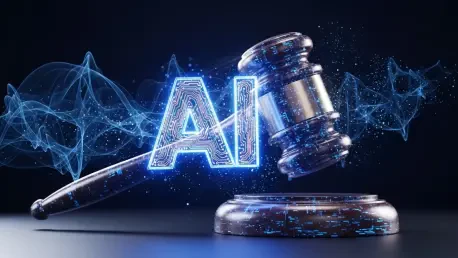Introduction to the AI Regulatory Landscape
The rapid ascent of artificial intelligence (AI) in the United States has transformed industries, with over 70% of major corporations in healthcare, finance, and national security integrating AI solutions into their operations, driving efficiency and innovation. However, this technological surge poses unprecedented challenges, from ethical dilemmas to potential threats to public safety, making the urgency to address these risks more apparent than ever and setting the stage for a critical debate on governing a technology that reshapes society at an astonishing pace.
Across the nation, key players such as leading tech giants and prominent research institutions are at the forefront of AI development, pushing boundaries with breakthroughs in machine learning and neural networks. These advancements, often powered by vast computational resources, enable capabilities ranging from predictive analytics in medicine to autonomous decision-making in defense systems. The scale of investment and the speed of deployment underscore the transformative potential of AI, but also highlight the gaps in oversight that could lead to unintended consequences.
The societal impact of AI cannot be overstated, as it influences everything from job markets to privacy rights, prompting a growing call for federal intervention. Without structured governance, the risks of misuse or systemic failures loom large, potentially undermining trust in these powerful tools. As a result, the push for comprehensive regulation has gained momentum, with lawmakers recognizing the need to balance innovation with accountability to safeguard public interests.
Details of the Artificial Intelligence Risk Evaluation Act
Core Components and Objectives of the Bill
On September 30, a bipartisan legislative effort led by Senators Josh Hawley (R-Mo.) and Richard Blumenthal (D-Conn.) introduced a groundbreaking framework aimed at regulating advanced AI systems. This bill establishes a federal evaluation process to ensure safety and reliability before such systems are deployed in interstate or foreign commerce. The primary goal is to mitigate risks by setting clear standards for developers, focusing on proactive measures rather than reactive fixes.
The legislation specifically targets advanced AI models defined by their immense computational training, exceeding 10^26 floating-point operations, a threshold indicative of highly sophisticated systems. Under this proposal, the Department of Energy would spearhead a risk evaluation program employing secure testing methodologies. Techniques like red-teaming, designed to uncover vulnerabilities, and third-party assessments for unbiased analysis, form the backbone of this initiative, aiming to enhance system integrity before public release.
Beyond immediate safety checks, the bill envisions a long-term impact by tasking the Energy Secretary with developing a permanent evaluation framework. This structure would not only guide developers in refining their technologies but also inform future regulatory standards. Such a forward-thinking approach seeks to embed accountability into the fabric of AI advancement, ensuring that societal benefits are prioritized alongside technical progress.
Enforcement Mechanisms and Penalties
To enforce adherence to the new standards, the proposed legislation introduces severe penalties for non-compliance, including a staggering $1,000,000 daily fine for operating advanced AI systems without federal clearance. This measure underscores the seriousness with which lawmakers view potential risks, aiming to deter developers from bypassing critical safety evaluations. The financial consequence serves as a powerful incentive for adherence to regulatory protocols.
Importantly, the scope of enforcement is narrowly tailored to focus solely on the most computationally intensive AI models, thereby avoiding undue burden on smaller-scale innovations. This targeted approach reflects an intent to address systems with the greatest potential for widespread societal impact while allowing flexibility for less complex technologies. Such precision in regulation aims to maintain a competitive edge in the industry without stifling growth.
Looking ahead, these enforcement mechanisms could redefine developer accountability, fostering a culture of transparency in AI deployment. By establishing clear consequences, the bill may encourage companies to prioritize safety, ultimately enhancing public trust in these technologies. The ripple effect of such measures might extend beyond immediate compliance, shaping ethical standards across the tech landscape for years to come.
Challenges in Regulating Advanced AI Systems
Regulating a technology as dynamic as AI presents formidable challenges, particularly in defining clear risk criteria amidst rapid innovation. The pace at which new models and applications emerge often outstrips the ability of policymakers to adapt, creating a gap between current laws and technological realities. This discrepancy complicates efforts to establish consistent guidelines that remain relevant over time.
Balancing competing priorities such as national security, civil liberties, and industry expansion adds another layer of complexity, a concern frequently voiced by Senator Hawley. Overregulation risks hampering economic growth and global competitiveness, while underregulation could expose vulnerabilities in critical systems. Striking an equilibrium that protects public interests without stifling creativity demands nuanced policy design and continuous dialogue with stakeholders.
Additionally, resistance from tech companies is anticipated, with many likely to argue that stringent rules impose unnecessary costs and delays. The potential for regulatory burdens to hinder smaller firms or startups is a valid critique, necessitating flexible policies that can evolve with emerging challenges. Adaptive frameworks, capable of addressing unforeseen issues, will be essential to ensure that oversight remains effective without becoming an obstacle to progress.
Current and Past Legislative Efforts on AI Oversight
The broader regulatory landscape for AI in the United States reveals a pattern of increasing attention to governance, with multiple bills addressing various facets of the technology. Earlier this year, Senators Hawley and Blumenthal collaborated on the AI Accountability and Personal Data Protection Act, which sought to regulate the use of sensitive consumer information in AI training. This effort reflects a consistent focus on privacy as a cornerstone of responsible development.
A noticeable bipartisan trend in Congress points toward comprehensive AI governance, emphasizing not just data protection but also safety and accountability. Lawmakers from diverse political backgrounds appear united in recognizing the urgency of establishing robust oversight mechanisms. This alignment suggests a shared understanding of AI’s dual role as both an opportunity and a potential risk to societal stability.
Compliance and security measures embedded in these legislative efforts are poised to reshape industry practices significantly. By mandating stricter protocols, such initiatives encourage companies to integrate safety considerations from the design stage onward. The resulting shift could bolster public confidence in AI systems, paving the way for broader acceptance and responsible deployment across sectors.
Future Implications for AI Governance and Innovation
The long-term impact of the proposed risk evaluation act on AI development in the United States could be profound, potentially setting a precedent for how advanced technologies are governed. By institutionalizing a federal evaluation process, the legislation might influence the trajectory of innovation, encouraging developers to prioritize safety without compromising on creativity. This structured approach could become a model for other nations grappling with similar challenges.
A permanent evaluation framework under the Energy Secretary’s leadership is likely to shape future regulations and industry standards over the coming years. From 2025 to 2027, as implementation details are refined, this framework could establish benchmarks for risk assessment that extend beyond AI to other emerging technologies. Such a proactive stance may position the United States as a leader in responsible tech governance on the global stage.
Emerging concerns, such as AI’s role in spreading misinformation or enabling autonomous weapons, highlight the need for continuous legislative adaptation. As global technological competition intensifies, staying ahead of these issues will require agile policymaking and international cooperation. The ability to address these evolving risks while fostering innovation will determine the effectiveness of governance strategies in the long run.
Conclusion and Outlook for AI Regulation
Reflecting on the discussions that unfolded, the bipartisan collaboration between Senators Hawley and Blumenthal stands as a testament to a unified resolve in tackling AI governance challenges. Their proposed legislation marks a pivotal moment in recognizing the necessity of federal oversight for advanced systems, prioritizing safety and accountability in a landscape often driven by speed and profit.
Looking back, the detailed framework and stringent penalties highlighted in the bill underscore a commitment to protecting public interests against potential technological harms. Moving forward, stakeholders are encouraged to engage in ongoing dialogue to refine evaluation processes, ensuring they remain adaptable to innovation’s rapid pace. This iterative approach promises to address gaps as they emerge.
As a next step, policymakers and industry leaders need to focus on building international partnerships to harmonize AI standards, preventing a fragmented regulatory environment. Investing in public education about AI risks and benefits also emerges as a critical action to foster informed discourse. These efforts, if pursued diligently, hold the potential to transform the proposed act into a cornerstone of responsible technological advancement.









